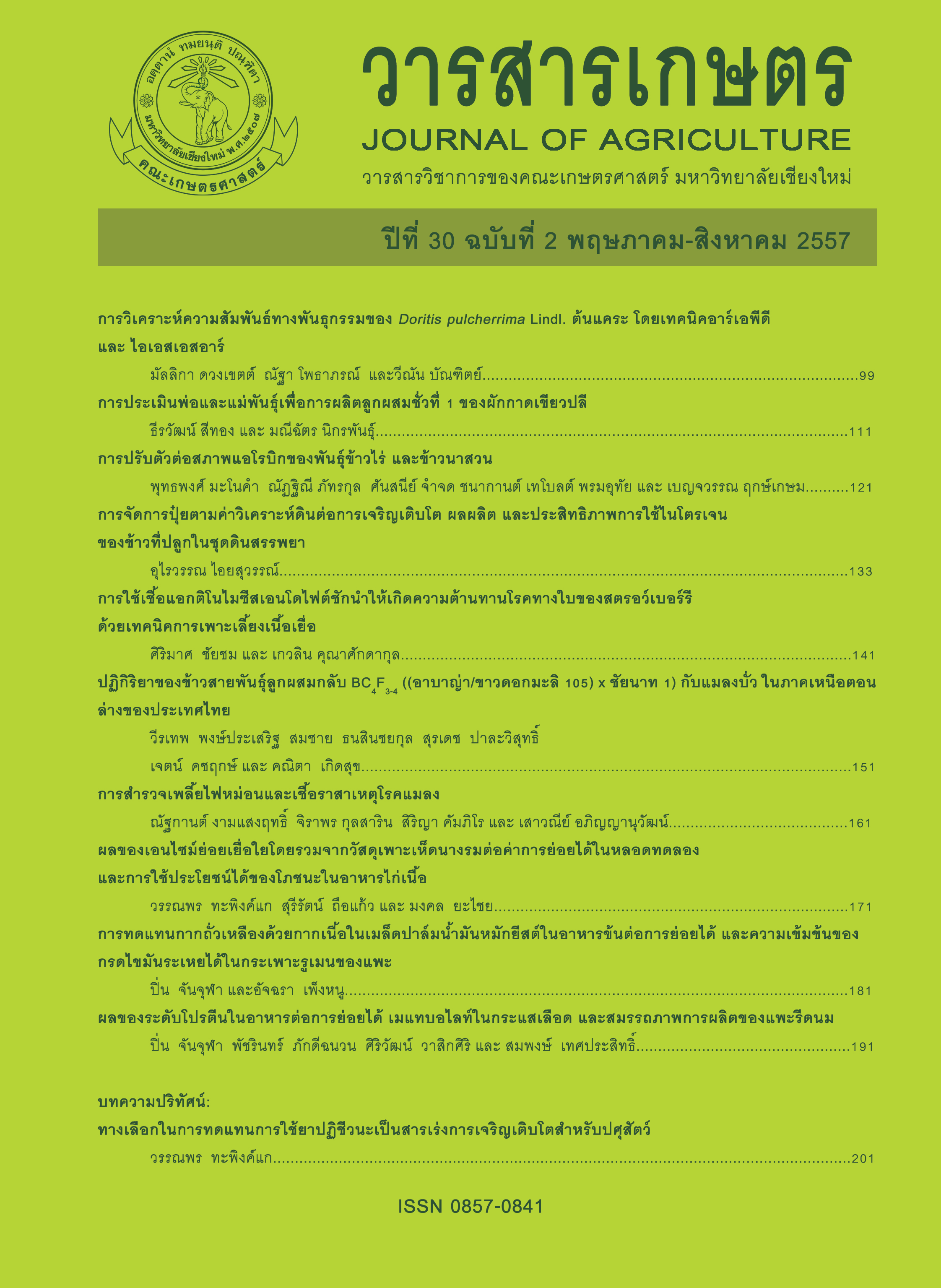ผลของระดับโปรตีนในอาหารต่อการย่อยได้ เมแทบอไลท์ ในกระแสเลือด และสมรรถภาพการผลิตของแพะรีดนม
Main Article Content
บทคัดย่อ
ศึกษาผลของระดับโปรตีนในอาหารข้นต่อการย่อยได้ เมแทบอไลท์ในเลือด และสมรรถภาพการผลิตของแพะรีดนม โดยสุ่มแพะให้ได้รับอาหารทดลอง 4 สูตร คือ อาหารข้นที่มีระดับโปรตีน 16, 17, 18 และ 19 เปอร์เซ็นต์ ตามแผนการทดลองแบบสลับ (Switch-back design) ใช้แพะนมลูกผสมเลือดซาเนน 75 เปอร์เซ็นต์ จำนวน 8 ตัว น้ำหนักเฉลี่ย 50 ±3.0 กิโลกรัม ซึ่งมีจำนวนวันของการให้นมเฉลี่ย 60 ±10 วัน โดยแพะนมทุกตัวให้กินหญ้ารูซี่สดเป็นอาหารหยาบแบบเต็มที่ และได้รับสัดส่วนอาหารข้นต่อปริมาณน้ำนมเป็น 1 ต่อ 2 ผลการทดลองพบว่า ปริมาณการกินได้ ผลผลิต และองค์ประกอบน้ำนมของทุกกลุ่มมีค่าใกล้เคียงกัน (P>0.05) ขณะที่ การย่อยได้ของโปรตีน และค่าความเข้มข้นของยูเรีย-ไนโตรเจนในน้ำนมเพิ่มขึ้นตามระดับโปรตีนในอาหารข้นที่เพิ่มขึ้น (P<0.05) จากผลการทดลองนี้สามารถสรุปได้ว่า ระดับโปรตีน 16-17 เปอร์เซ็นต์ ในสูตรอาหารข้น เป็นระดับที่เหมาะสมสำหรับแพะรีดนม โดยไม่มีผลต่อปริมาณการกินได้ ผลผลิตและองค์ประกอบของน้ำนม
Article Details
References
มาตรฐานสินค้าเกษตรและอาหารแห่งชาติ (ออนไลน์). แหล่งข้อมูล: http://acfs.go.th.pdf. ค้นเมื่อ 5 มกราคม 2556.
สุภาณี ด่านวิริยะกุล สุเมธี กิตติพงศ์ไพศาล สมเกียรติ ศีลสุทธิ์ และ นงเยาว์ จันทราช. 2556. อิทธิพลของรูปแบบการให้อาหารต่อปริมาณและองค์ประกอบทางเคมีของน้ำนมแพะ. วารสารเกษตร 29(2):107-116.
อารีย์วรรณ มีแสง ปิ่น จันจุฬา วันวิศาข์ งามผ่องใส และ อภิชาติ หล่อเพชร. 2554. ผลการใช้กากเนื้อในเมล็ดปาล์มน้ำมันในสูตรอาหารข้นต่อการย่อยได้ และนิเวศวิทยาในกระเพาะรูเมนของแพะ. วารสารเกษตร 27(1): 87-99.
AOAC. 1990. Official Method of Analysis. Association of Official Analytical Chemists, Washington, D.C.
Arieli, A., R. Sasson-Rath, S. Zamwel and S. J. Mabjeesh. 2005. Effect of dietary protein and rumen degradable organic matter on milk production and efficiency in heat-stressed goats. Livestock Production Science 96: 215-223.
Bremner, J. M. and D. R. Keeney. 1965. Steam distillation methods of determination of ammonium nitrate and nitrite. Analytica Chimica Acta 32: 485-493.
Broderick, G. A. and M. K. Clayton. 1997. A statistical evaluation of animal and nutritional factors influencing concentrations of milk urea nitrogen. Journal of Dairy Science 80: 2964-2971.
Butler, W. R., J. J. Calaman and S. W. Beam. 1996. Plasma and milk urea nitrogen in rational to pregnancy rate in lactating dairy cattle. Journal of Animal Science 74: 858-865.
Clark, J. H. and C. L. Davis. 1980. Some aspects of feeding high producing dairy cows. Journal of Dairy Science 63: 873-891.
Clark, S. and J. W. Sherbon. 2000. Alphas1-casine milk composition and coagulation properties of goat milk. Small Ruminant Research 38: 123-134.
Crocker, C. L. 1967. Rapid determination of urea-nitrogen in serum or plasma without deproteinization. American Journal of Medical Technology 33: 361-365.
Ferguson, J. D., D. T. Galligan, T. Blanchard and M. Reeves. 1993. Serum urea nitrogen and conception rate: the usefulness of test information. Journal of Dairy Science 76: 3742-3746.
Goering, H. K. and P. J. Van Soest. 1970. Forage Fiber Analysis (Apparatus, Reagent, Procedures and some Application). Agric. Handbook. No. 397, ARS, USDA, Washington, D.C.
Grings, E. F., R. E. Roffler and D. P. Dietelhoff. 1991. Response of dairy cows in early lactation to addition of cotton seed meal in alfalfa hay based diets. Journal of Dairy Science 74: 2580-2587.
Holter, J. B., J. A. Byrne and C. G. Schwab. 1982. Crude protein for high milk production. Journal of Dairy Science 65: 1175-1188.
Jain, N. C. 1993. Essential of Veterinary Hematology. Lea & Febiger. Philadelphia.
Kaneko, J. J. 1980. Appendixes. In: Ed. J. J. Kaneko. Clinical Biochemistry of Domestic Animals, 3rd ed. New York, Academic Press.
Kung, L. Jr. and J. T. Huber. 1983. Performance of high producing cows in early lactation fed protein of varying amounts, sources, and degradability. Journal of Dairy Science 66: 227-234.
Lloyd, S. 1982. Blood characteristics and the nutrition of ruminants. British Veterinary Journal 138: 70-85.
McCarthy, R. D., Jr., T. H. Klusneyer, J. L. Vicini, J. H. Clark and D. R. Nelson. 1989. Effects of source protein and carbohydrate on ruminal fermentation an passage of nutrients to the small intestine of lactation cows. Journal of Dairy Science 72: 2002-2016.
Murry A. C., Jr., S. Gelaye, J. M. Casey, T. L. Fout, T. L. Foutz, B. Kouakou and D. Arora. 1999. Type of milk consumed can influence plasma concentrations of fatty acid and minerals and body composition in infant and weaning pigs. Journal of Nutrition 129: 132-138.
NRC. 1981. Nutrient Requirements of Goats: Angora, Dairy and Meat Goat in Temperate and Tropical Countries. National Academy of Sciences, Washington, DC.
Olmos Colmenero, J. J. and G. A. Broderick. 2006. Effect of dietary crude protein concentration on milk production and nitrogen utilization in lactating dairy cows. Journal of Dairy Science 89: 1704-1712.
Preston, R. L., D. D. Schnakanberg and W. H. Pfander. 1965. Protein utilization in ruminants. I. Blood urea nitrogen as affected by protein intake. Journal of Nutrition 86: 281-287.
Roffler, R. E., J. E. Wary and L. D. Satter. 1986. Production responses in early lactation to addition of soybean meal to diets containing predominantly corn silage. Journal of Dairy Science 69:1055-1062.
Sanz Sampelayo, M. R., L. Amigo, J. L. Ares, B. Sanz and J. Boza. 1998. The use of diets with different protein sources in lactating goats: composition of milk and its suitability for cheese production. Small Ruminant Research 31: 37-43.
Steel, R. G. D. and J. H. Torrie. 1980. Principles and Procedures of Statistics: A Biometerial Approach. (2nd ed.). McGraw-Hill, New York, USA.
Van Keulen, J. and B. A. Young. 1977. Evaluation of acid insoluble ash as a neutral marker in ruminant digestibility studies. Journal of Animal Science 44: 282-287.
Wasiksiri, S., U. Chethanond, S. Pongprayoon, S. Srimai and B. Nasae. 2010. Quality aspects of raw goat milk in Lower Southern Thailand. Songklanakarin Journal of Science and Technology 32: 109-113.

